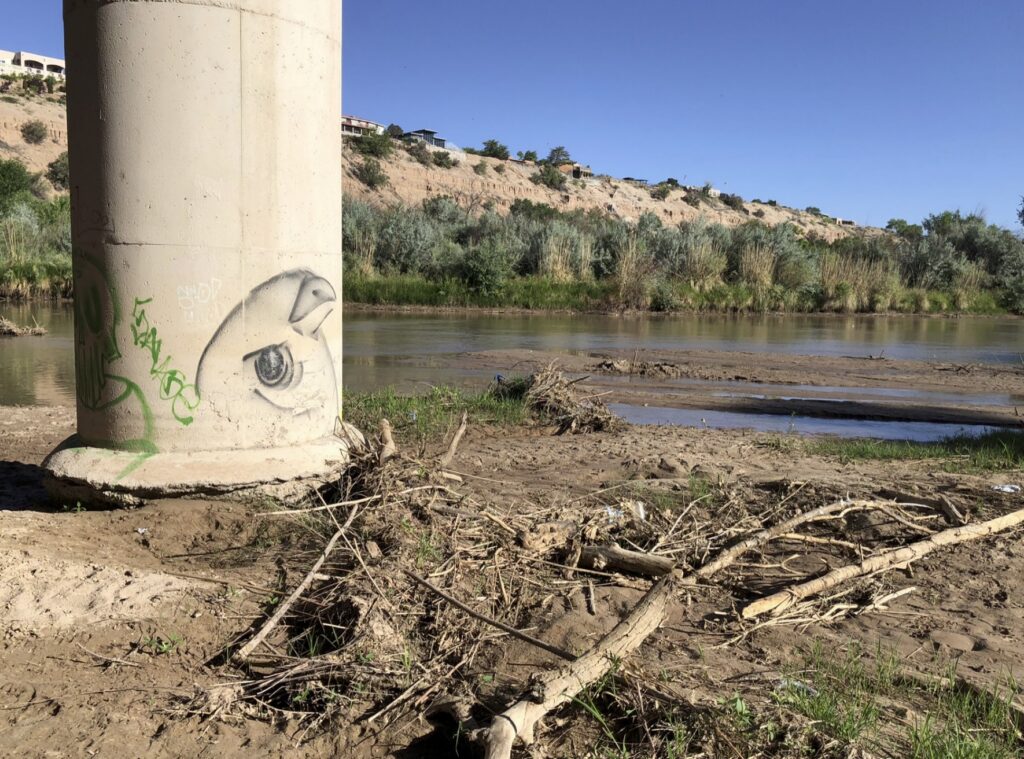
Rio Grande Monday, 6/6/22, under the I-40 bridge in Albuquerque. Not dry yet!
A few notes on New Mexico’s Rio Grande in 2022, as I collect my thoughts for a TV interview later today:
Snowpack and runoff
- Snowpack peaked at ~80 percent of the median
- Runoff into NM’s middle valley looks to be less than 50 percent (maybe quite a bit less?)
Dry spell
As I write this a bit before sunup on June 8, 2022, the NWS offers me a 20 percent chance of precipitation this afternoon. Through yesterday, we’ve gone 69 straight days without measurable rain or snow at the Albuquerque NWS complex. That’s the 19th longest streak on record, going back more than a century.
Put another and perhaps more meaningful way – 1.19 inches of precip at the airport since Oct. 1 is the fourth driest start to a water year in the aforementioned century-plus of records.
Current flow
Current Rio Grande flow at the San Felipe gage north of Albuquerque (my best measure of river flow entering this part of the valley) is the lowest it’s been on this date since 1989.
Current not flow
The river began drying south of Albuquerque over the weekend like that (sound effect of sharp finger snap). We had more than 20 miles go dry by Monday morning, I don’t have the latest data, but I talked to one of the folks working down there who said things are drying so fast that they’re not seeing the usual number of stranded pools as flows drop. This seems to suggest a fading shallow aquifer after our third dry year in a row.
Whither the riverside forests, our beloved bosque, which depend on that shallow aquifer? Further research needed.
Future not flow
Last year Cassandras such as myself warned of river drying in the Albuquerque reach for the first time since the 1980s. It did not dry. It rained.
Cue Cassandra, who enters stage left.
If it does not rain again, we could see drying in the Albuquerque reach this year for the first time since 1983.
Irrigation
Not. Upstream storage, on which we normally depend for irrigation water in the middle valley, is zip, nada, etc., except for some loose change in the couch cushions. USBR data web site is down this morning, but I think it’s fair to guess that zip, nada, etc., is similar to the lowest it’s ever been at this time of year? How could it be otherwise?
Ditches are already starting to go dry, and it’s still early June.
Municipal supplies
Albuquerque’s plan was to shut down its river diversions ~June 15 because flows would be too low. That could well happen sooner. We’ve got groundwater to fall back on, an “emergency reserve” we’ll have to tap into for the third consecutive year. (Disclosure: I serve on the Albuquerque Bernalillo County Water Utility Authority’s Technical Customer Advisory Committee, where we gather monthly over Zoom to talk about things like this.)
Fond memories
I went on a bike ride Monday morning down one of the riverside trails. There’s a point just north of Central Avenue where the trail drops to a low spot that filled in late spring 2019 and stayed impassable for months.
I did not mind that my favorite trail was impassable.
I rode up to it, to the water slipping quietly back into the bosque, many many times, turned around and went another way.
Made me smile every time.
It’s quite dry there this year.

Avid reader of your blog and just finished your book. Best of luck on your interview today. I enjoy your persistent optimism about Colorado River and tributary conditions, but it seems like there is a lot of bad news out there right now, between reading your blog posts here about New Mexico and reading in the news about how bad things are in California. I also read recently that San Diego representatives thought they shouldn’t have to participate in state mandated water cuts because they had senior and secure supplies of Colorado River water rather than State Water project water. I think to myself, have the representatives of San Diego seen Lake Mead recently? How secure can those water rights really be?
Anyways, I’ve been curious now for over five years what a worst case scenario on the Colorado River system actually looks like in real life. I can’t find any literature or contemporary articles on it, perhaps because no one knows? But with Lake Mead water levels dropping, does California even have the power to pump water through the All American Canal if Mead drops to minimum power pool? What happens if Lake Powell drops to or below minimum power pool in terms of Lake Mead operations? What is the earliest there could be a compact call on the Colorado River and how might Upper Basin states respond? All of this is happening during poor but not catastrophically low snowfall. What if we had a truly terrible snowfall season in the next few years?
Anyways, that’s a lot, but thanks for what you do and keep up the awesome work.
Yeah, it’s really dismal. And conditions like these will like get more frequent. Pioneering spirit and luck might not persevere